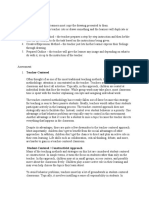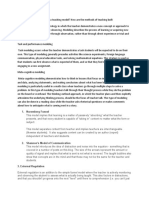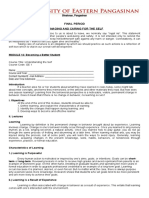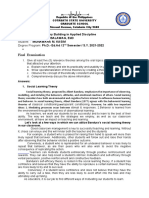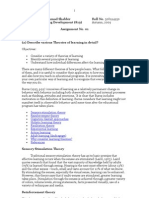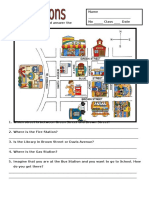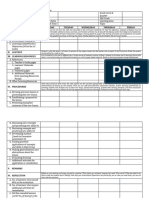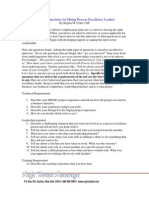Justification
Justification
Uploaded by
Hasfiyah AssanCopyright:
Available Formats
Justification
Justification
Uploaded by
Hasfiyah AssanOriginal Description:
Copyright
Available Formats
Share this document
Did you find this document useful?
Is this content inappropriate?
Copyright:
Available Formats
Justification
Justification
Uploaded by
Hasfiyah AssanCopyright:
Available Formats
JUSTIFICATION A protruding characteristic of the original behaviorist model is its emphasis on teachers' and pupils' observable development and
changes. In an educational environment these are seen as representing effects and outcome of teaching and the sign of learning and understanding among the pupils. The same general idea covers both teachers and pupil's behavior because the model rests on a very heavy body of empirical research findings from educational psychology. The theoretical foundations for this kind of teaching are derived from behaviorist learning theories. Its historical roots are found in theories presented by Watson (1924), Thorndike (1903, 1932), Skinner (1975) and many other more recent researchers. Among these Gage and Berliner (1992) or Bandura (1970) can be mentioned. The behaviorist model tells the teacher that it is important to use reinforcements in form of rewards (punishments are from an ethical standpoint not acceptable) as tools for making teaching effective. Concretely this means that the teacher will make systematic use of reinforcement during his or her lessons, by rewarding students who respond in the intended way and not giving reinforcement to students who do not. What is regarded as a reward is almost everything that carries meaning or value to the student. It can be a comment from the teacher written in a home assignment or a gold star put on the front page of the student's coursework. A reinforcement or reward might be a smile from the teacher, a nodding when the student says something, or just plain attention when asking for it. Indeed, attention is one of the most potent reinforcing instruments teachers can make use of when teaching and it is therefore normally very rewarding to the students. All students receiving reinforcement are highly probable to repeat the behavior that resulted in the reward. According to modern behaviorist theories this is not solely a question of overt behavior but can be transferred to all areas of learning like thinking, problem solving, linguistics and verbal competence and social learning. Furthermore, a teacher making systematic and intelligent use of reinforcement will get highly motivated students who work hard to succeed and fulfill the requirements of the school curriculum. The behaviorist model is present in all interactive situations in school. In every situation where the teacher and the pupil are engaged in verbal interchange, reinforcement is present in various ways. It must not be as obvious as an
appreciative word. It might be, as mentioned above, a nod, a glance, a lifted eyebrow or simply attention or an indication of interest. It is often claimed that the grading of the students' study performances is necessary because it has a motivating and rewarding effect on pupils. But even if this may be true in the sense that successful pupils seem to be highly interested in their schoolwork and school performances, there is also a negative effect. Students who seldom or never receive any reinforcements or rewards tend to lose interest in their school performances. This reaction is easy to understand as nobody will get motivated or prepared to invest a lot of intellectual or physical effort into something that nobody considers to be of relevance. Teaching can be assessed and understood by what the teacher does in the classroom and what visible effects the teacher's work has on the pupil's learning, understanding, intellectual growth or skills. Successful teaching might be identified as something successful teachers are doing when carrying out teacher's work in its full range. From this it is reasonable to stress the importance of good models to use as study objects in order to influence the pupil. This approach is two sided and of the same relevance for teachers or student teachers and school children. Taking the behaviorist approach as a point of departure we can easy turn to a specific type of learning called model learning, modeling or vicarious learning (Bandura, 1970), from which it is assumed that the pupils learn skills, moral and how to behave in various situations. School teaching, then, is the conscious implementation of this very natural way of influencing pupils in directions wanted. There is three model of teaching in the behavioral theory. Three of them are direct instruction model, mastery learning model and programmed instructional model. First of all, I will be touching on with the direct instruction model. Direct instruction model was implemented by Albert Bandura. Direct instruction model is the oldest form of teaching model. The teacher uses the direct strategy of teaching. And this model is the most commonly used strategy nowadays. The reasons why the teachers use the direct instruction model is because of it is the most effective strategy in teaching step by step skills. It is also a good tool for introducing students to other methods of instruction. It also involved students in knowledge development and it introduces topic and almost subjects backwards. There are some steps that are involved in using the model. The steps are daily reviews step which reviewing or recall each session daily, presenting new materials, guided practice where the teacher guide the students if they do not understand the topic, corrections and feedback, independent practice and weekly and monthly
reviews for knowledge. The methods that can be used by teacher for using the model are lecture, practice, questions and discussions. The next model would be the mastery learning model. The model is pioneered by Benjamin Bloom. According to Davis and Sorrel (1995), the mastery learning method divides subject matter into units that have predetermined objectives or unit expectations. The researchers also claimed that students must demonstrate mastery on unit exams, typically 80%, before moving on to new material. Students who do not achieve mastery receive remediation through tutoring, peer monitoring, small group discussions, or additional homework. Additional time for learning is prescribed for those requiring remediation. Students continue the cycle of studying and testing until mastery is met. There are three elements involved of mastery learning. First is feedback element. This element reinforces the essential objectives, recognizes what was done well and identifies what needs more work. Second element is correctives element. It explicit guidance on how to improve errors initial instruction which is the materials should be presented differently and students should be involved differently. And the last element is the enrichment of mastery learning. The opportunities is to broaden learning and higher level activities. The examples of lesson activities for this model are pre-test or post-test, using the journals, quiz and concept map. The last model is programmed instruction model. According to Dale and Edgar (1962), this model is a systematic step-by-step, self-instructional programed aimed to ensure the learning of stated behavior. This model assumes that technology is no specific machine or piece of hardware and this model is a distinct process or method for doing something. It also assumes that it is a self-paced-different learner can learn at the rate most comfortable to them. The good example for using the model is the computer assisted instruction (CIA). C.I.A is the using or application of technology and computer system during the teaching and learning process. The example for the activity that can be done is the pupils follow designed learning materials in software without the teachers help. The teacher then must facilitate the students to have interest in manipulating computer. One of the main strengths of the behaviorist approach is that it focuses only on behaviour that can be observed and manipulated. Therefore, this approach has proved very useful in experiments under laboratory conditions where behaviour can be observed and manipulated, especially in relation to the IV (independent variable) and the DV (dependent
variable). The behaviorist principles of learning have been, and continue to be, tested in the laboratory where learning can be objectively measured. The behaviorist approach concentrates on the 'here and now' rather than exploring a person's past or their medical history. This is an advantage because many people do not know the past causes for their abnormal behaviour. And for many people getting rid of undesirable behaviour may be more important than understanding the causes of such behaviour. For example, a client with an irrational compulsion to wash his hands unnecessarily many times every day may be satisfied by simply ridding himself of the abnormal behaviour. On the other hand, if an approach cannot treat the underlying causes of the behaviour, it is likely the behaviour will return after a period of time. Behavioral treatments such as Systematic Desensitization and Token Economies are effective for certain disorders, such as obsessive-compulsive disorders and phobias. However, they are not so effective for more serious disorders, such as schizophrenia. The behaviorist approach has been criticized for suggesting that most human behaviour is mechanical, and that human behaviour is simply the product of stimulus-response behaviors. This seems to be a very reductionist attitude. In particular, the approach ignores human beings' complex thought processes (cognition) and emotions. In Social Learning Theory, Bandura (1977) has revealed that cognitive factors cannot be ignored if learning is to be understood. Bandura has pointed out that it is knowing, having the information, that certain behaviors will be rewarded or punished that shapes behaviour just as much as the rewards or punishments themselves. For example, Little Johnny knows he will be smacked for touching the electric fire, and that is why he does not touch it. In addition, the principles of behaviorism have been tested mainly on animals. Such findings may not apply totally to human behaviour, which is much more complex. Finally, ethical questions have been raised over some behavioral treatments which have been used without the consent of the client, and in treatments such as Aversion Therapy where pain and discomfort are deliberately used to change the behaviour of the client. When considering their approach to instruction, teachers are always looking for the method that is most beneficial for all of their students. Teachers want their students to enjoy the learning process, and they want the classroom to be orderly and controlled. As a result, the debate of teacher-centered vs. student-centered education has been in the forefront of
educators minds for many years. Though many people have a specific idea of which type of education is best, there are both advantages and disadvantages to each approach. In our lesson plan, we consider it as a teacher-centered. In teacher-centered education, students put all of their focus on the teacher. The teacher talks, while the students exclusively listen. During activities, students have to follow the teachers instruction. When education is teacher-centered, the classroom remains orderly. Students are quiet, and the teacher retains full control of the classroom and its activities. Because students learn on their own, they learn to be independent and make their own decisions. Because the teacher directs all classroom activities, they dont have to worry that students will miss an important topic. As we know, nowadays, teachers prefer to teach the students based on the behaviorist model. Our lesson plan is used based on the concept of direct instruction model. The direct instruction model provides the opportunity for students to receive information from the teacher through lecture, demonstration or presentations. The purpose of the model is to provide students with the opportunity to receive information directly about a subject and begin to cognitively apply that information to previous learning. Direct instruction also serves as a tool for teachers to provide a variety of information that is needed about a subject and then allow the students the opportunity to use that information as a foundation for later work. As we can see in our lesson plan, first 5 minutes were used in set induction stage. During this stage, the teacher announces the topic for the day and introduces the special guest which is Doreamon. As we can see, when the teacher gives an instruction, the students will follow what the teacher had instructed. Then, the teacher will show the slide show of Fruit Shake song lyrics in front of the class. During development stage, the teacher required 20 minutes in step 1, 25 minutes in step 2 and 15 minutes in step 3. During step 2 in development stage, the concept of direct instructional model used often. The teacher will ask the students to get into their group. After that, the teacher asks them to replace the name of the fruit which they had selected into the songs lyrics and they have to use the musical instruments given. The teacher will explain briefly about the whole things and gives 5 minutes for them to practice their songs In development step 3, the teacher will carry out Spelling Bee and the students need to write down their answer. The group that getting highest marks will be announced as a winner. The teacher also will help the students if the students having a problem during this activity.
Direction instruction is the most widely used method of teaching. Recent studies cast doubts about whether it is the best way to teach, but it is empirically proven to be able to consistently raise the average test scores of a school. This has resulted in the success of the teaching method and its widespread use in the classroom.
You might also like
- KS2 Writing MR ChownDocument40 pagesKS2 Writing MR ChownAndy Chown100% (1)
- Conflict Resolution in The CockpitDocument2 pagesConflict Resolution in The Cockpitcheekybean100% (2)
- Finals Lesson 3 Behavioral Learning Theories and Approaches To LearningDocument19 pagesFinals Lesson 3 Behavioral Learning Theories and Approaches To LearningVivian Paula PresadoNo ratings yet
- Reflection 2 PhychologyDocument3 pagesReflection 2 PhychologynitiyahsegarNo ratings yet
- Dale BehaviorismDocument9 pagesDale BehaviorismLester Khylle PeritoNo ratings yet
- Lesson 4 Beetc 680Document5 pagesLesson 4 Beetc 680ayeshastudies888No ratings yet
- Apunte Importante para El CbestDocument4 pagesApunte Importante para El CbestCenobioNo ratings yet
- Practice TeachingDocument13 pagesPractice TeachingHoneeya Guro Dirampatun-BataborNo ratings yet
- Definitions - GENERAL METHODs OF TEACHINGDocument1 pageDefinitions - GENERAL METHODs OF TEACHINGAMJAD NASIR KAYANINo ratings yet
- Assimilation Accommodation: ConstructivismDocument13 pagesAssimilation Accommodation: ConstructivismWalid WacNo ratings yet
- Educ 5312-Research Paper TemplateDocument6 pagesEduc 5312-Research Paper Templateapi-357822494No ratings yet
- Level: Curriculum Development (6406) Semester: Autumn, 2021 Course: ADE/ B.Ed (4years) Name: Saba NawazDocument21 pagesLevel: Curriculum Development (6406) Semester: Autumn, 2021 Course: ADE/ B.Ed (4years) Name: Saba NawazMuhammad Bilal100% (1)
- MODULE IV: Pedagogy of Values/ Methods of Teaching Values EducationDocument4 pagesMODULE IV: Pedagogy of Values/ Methods of Teaching Values EducationKlyde PasuquinNo ratings yet
- COGNITIVISMDocument25 pagesCOGNITIVISMJhun Rey MoralesNo ratings yet
- Implications of Theories - Q3 - 201048564Document4 pagesImplications of Theories - Q3 - 201048564daibysenekaNo ratings yet
- L 200 Unit 7Document19 pagesL 200 Unit 7abrokwah sethNo ratings yet
- SOCIAL STUDIES Activity No. 7Document6 pagesSOCIAL STUDIES Activity No. 7Jen AMBNo ratings yet
- Med 02: Educational Research and Desigs, Methods andDocument5 pagesMed 02: Educational Research and Desigs, Methods andMaria VanessaNo ratings yet
- Submitted-Jenelyn R. Andrino (Learning Tasks & Assessments TEGr112 Module 4)Document9 pagesSubmitted-Jenelyn R. Andrino (Learning Tasks & Assessments TEGr112 Module 4)Jenelyn AndrinoNo ratings yet
- Educ 5312-Research Recep BatarDocument6 pagesEduc 5312-Research Recep Batarapi-290710546No ratings yet
- Educ 5312-Research Paper-M Keles 2Document4 pagesEduc 5312-Research Paper-M Keles 2api-316855144No ratings yet
- Active Learning VsDocument6 pagesActive Learning VsBlinky Antonette FuentesNo ratings yet
- ProductionDocument10 pagesProductionMary Grace VelezNo ratings yet
- Nuremberg FunnelDocument13 pagesNuremberg FunnelBukhari EnterprisesNo ratings yet
- New Lessons - Understanding SelfDocument10 pagesNew Lessons - Understanding Self란지 리오No ratings yet
- Philosophy of TeachingDocument3 pagesPhilosophy of TeachingDhea DillaNo ratings yet
- Lesson Plan CompilationDocument8 pagesLesson Plan CompilationEljemay C. Abellanosa100% (1)
- Uts Module 12Document6 pagesUts Module 12Cristobal CantorNo ratings yet
- Reflection Learning TheoryDocument9 pagesReflection Learning TheoryIntan SayangNo ratings yet
- Active Learning VsDocument9 pagesActive Learning VsBlinky Antonette FuentesNo ratings yet
- Bilek Halim Educ 5312-Research PaperDocument6 pagesBilek Halim Educ 5312-Research Paperapi-322653911No ratings yet
- Module 1 - Semi Finals - Different Approaches and MethodsDocument6 pagesModule 1 - Semi Finals - Different Approaches and Methodsvianvi3No ratings yet
- 706 - Final Exam-KASIMDocument11 pages706 - Final Exam-KASIMMonkey D LuffyNo ratings yet
- Name: Upie Pamulasri Reg. Number: A1M2 16 070 Class: B Subject: Tefl IiDocument5 pagesName: Upie Pamulasri Reg. Number: A1M2 16 070 Class: B Subject: Tefl IiupieNo ratings yet
- Reflection 1 EDCI7101Document6 pagesReflection 1 EDCI7101g-66410086No ratings yet
- April 26 Prof Ed 4Document3 pagesApril 26 Prof Ed 4Anjo M. MapagdalitaNo ratings yet
- Learning TheoriesDocument7 pagesLearning Theorieshamza ShahidNo ratings yet
- Creating English EnvironmentDocument12 pagesCreating English EnvironmentEvgeniya YugayNo ratings yet
- PR2 GR12Document20 pagesPR2 GR12Ezrah Uriah OliverosNo ratings yet
- CHAPTER 1,2,3 COMB. 5th and Final RevisionDocument38 pagesCHAPTER 1,2,3 COMB. 5th and Final RevisionMokong MakalinogNo ratings yet
- GROUP 4_ METHODS OF TEACHING LEARNINGDocument10 pagesGROUP 4_ METHODS OF TEACHING LEARNINGgarubakamilahNo ratings yet
- Siatta Garwuo KCB - Unit 3 Theories Principles and Models in Education and Training 2Document25 pagesSiatta Garwuo KCB - Unit 3 Theories Principles and Models in Education and Training 2kamalhossen100% (1)
- Adult Learning TheoryDocument11 pagesAdult Learning TheoryKuna 96100% (1)
- Final Exam (PRINCIPLE OF TEACHINGDocument3 pagesFinal Exam (PRINCIPLE OF TEACHINGKenneth MolinaNo ratings yet
- Deductive and InductiveDocument8 pagesDeductive and InductiveCDT PVT YVONE CLAIRE A HOMECILLO 3CL ROTCNo ratings yet
- Principles of Teaching AgnoDocument9 pagesPrinciples of Teaching AgnoGlenda Lyn ArañoNo ratings yet
- Article 1 - Learing TheoriesDocument5 pagesArticle 1 - Learing TheoriesKavitha AlwisNo ratings yet
- Topic 10Document7 pagesTopic 10lizznadupoiNo ratings yet
- TRG & Dev 819Document27 pagesTRG & Dev 819Muhammad ShabbirNo ratings yet
- Lecture 27Document8 pagesLecture 27junaid khanNo ratings yet
- All_Document_Reader_1720458694254Document27 pagesAll_Document_Reader_1720458694254oswardmathias006No ratings yet
- Pedagogy For Positive LearningDocument23 pagesPedagogy For Positive Learningapi-435783953No ratings yet
- Chapter 9 SummaryDocument5 pagesChapter 9 SummarymualtukNo ratings yet
- Assignment 1A Learning TheoriesDocument10 pagesAssignment 1A Learning Theorieslevy2011No ratings yet
- Unit 2 Prtfolio SubmissionDocument6 pagesUnit 2 Prtfolio SubmissionAni JonesNo ratings yet
- Ed 808 Advanced Educational Psychology Dr. BustosDocument6 pagesEd 808 Advanced Educational Psychology Dr. BustosDecember-Anne CabatlaoNo ratings yet
- The Application of Theories - EducationDocument6 pagesThe Application of Theories - EducationLIEZEL ANN ORDINANNo ratings yet
- Assessment For Learning in Classroom: Unit - IiDocument92 pagesAssessment For Learning in Classroom: Unit - IiMalini DharmarajNo ratings yet
- Week 1Document19 pagesWeek 1MiRa bouflihNo ratings yet
- Pragmatic Approach To LearningDocument4 pagesPragmatic Approach To LearningjajusriramNo ratings yet
- Reaction Paper IN Sted 2: Inocencio, Donita Rose M. Bsed Iii - EnglishDocument7 pagesReaction Paper IN Sted 2: Inocencio, Donita Rose M. Bsed Iii - EnglishKeiKoNo ratings yet
- PDPR English Year 6 (15:7:2021)Document2 pagesPDPR English Year 6 (15:7:2021)Hasfiyah AssanNo ratings yet
- 5.1 Song LyricDocument2 pages5.1 Song LyricHasfiyah AssanNo ratings yet
- Post ActivityDocument10 pagesPost ActivityHasfiyah AssanNo ratings yet
- 5.1 Song LyricDocument2 pages5.1 Song LyricHasfiyah AssanNo ratings yet
- Adjectives Year 3Document3 pagesAdjectives Year 3Hasfiyah Assan100% (1)
- DirectionsDocument2 pagesDirectionsHasfiyah AssanNo ratings yet
- Body PartsDocument1 pageBody PartsHasfiyah AssanNo ratings yet
- Humanistic-Constructivist Theories 2013Document29 pagesHumanistic-Constructivist Theories 2013Hasfiyah AssanNo ratings yet
- Festivals in MalaysiaDocument1 pageFestivals in MalaysiaHasfiyah AssanNo ratings yet
- The Social Learning Theory (Tutorial WK 5)Document14 pagesThe Social Learning Theory (Tutorial WK 5)Hasfiyah AssanNo ratings yet
- Section B - MaximDocument3 pagesSection B - MaximHasfiyah AssanNo ratings yet
- Albert Bandura: Social / Observational LearningDocument22 pagesAlbert Bandura: Social / Observational LearningHasfiyah AssanNo ratings yet
- KWL Chart: Think, Pair, ShareDocument13 pagesKWL Chart: Think, Pair, Shareapi-242127878No ratings yet
- Research MethodologyDocument6 pagesResearch MethodologyNasir AliNo ratings yet
- DeterminersDocument34 pagesDeterminersJovelle CaraanNo ratings yet
- 1 SHS DAILY LESSON LOG DLL TEMPLATE byDocument3 pages1 SHS DAILY LESSON LOG DLL TEMPLATE byRodel EspañolaNo ratings yet
- Irregular Verbs Test 1Document1 pageIrregular Verbs Test 1Christian Leyte ChávezNo ratings yet
- ACT Science 1Document10 pagesACT Science 1innervisionscmNo ratings yet
- Recognizing Verb Tense Shift ErrorsDocument2 pagesRecognizing Verb Tense Shift ErrorsCherry Mae SanchezNo ratings yet
- Interview Questions For Hiring Process Excellence LeadersDocument3 pagesInterview Questions For Hiring Process Excellence LeadersBeenish SaiyedNo ratings yet
- Unit 1 - Vocab - LeadershipDocument2 pagesUnit 1 - Vocab - LeadershipK61.FTU LÊ THỊ MINH THƯNo ratings yet
- Data Science PPT-2Document34 pagesData Science PPT-2HiteshNo ratings yet
- JNM 451 Assignment Three MBDocument5 pagesJNM 451 Assignment Three MBNtuthu TshoksNo ratings yet
- Duolingo Method WhitepaperDocument19 pagesDuolingo Method Whitepaperdede1243No ratings yet
- The Absurdity of Reality: Case Study in The Meaninglessness of All ViewsDocument26 pagesThe Absurdity of Reality: Case Study in The Meaninglessness of All ViewsgamahucherNo ratings yet
- Ielts Listening Task Type 2 Matching 2Document7 pagesIelts Listening Task Type 2 Matching 2Mazen FawazNo ratings yet
- Neuroplasticity Exercises' Influence On Adolescent StudentsDocument14 pagesNeuroplasticity Exercises' Influence On Adolescent Studentsapi-599270977No ratings yet
- Cognitive Behavioral Therapy SummaryDocument3 pagesCognitive Behavioral Therapy SummaryAri100% (1)
- Personal, Possessive Pronouns and Verb To BeDocument9 pagesPersonal, Possessive Pronouns and Verb To BeMarmun Chivanguire ChivanguireNo ratings yet
- Chapter I, II Adaptation in TranslaltionDocument22 pagesChapter I, II Adaptation in TranslaltionBayu Jati PamelingNo ratings yet
- Plot and Navigate A Virtual Maze: Capstone ProjectDocument22 pagesPlot and Navigate A Virtual Maze: Capstone ProjecthazemtarekNo ratings yet
- Session Plan Sector Qualification Unit of Competency Module Title Learning OutcomesDocument3 pagesSession Plan Sector Qualification Unit of Competency Module Title Learning OutcomeswilbertNo ratings yet
- Lesson Plan Persuasive WritingDocument13 pagesLesson Plan Persuasive Writingapi-280247034100% (1)
- Swun Math 4 30Document3 pagesSwun Math 4 30api-245889774No ratings yet
- Name - Class - Group 2 1. Make The Present Continuous - Positive, Negative or Question!Document2 pagesName - Class - Group 2 1. Make The Present Continuous - Positive, Negative or Question!Farmasi Struga Jule Naracki-ClenstvoNo ratings yet
- Test Bank For Understanding Abnormal Behavior 10th Edition SueDocument23 pagesTest Bank For Understanding Abnormal Behavior 10th Edition SueHannah Smith100% (37)
- Cba Worksheet - Second ConditionalDocument2 pagesCba Worksheet - Second ConditionalEduardo ChávezNo ratings yet
- MathsDocument1 pageMathsskatare22No ratings yet
- Awakening ClarityDocument41 pagesAwakening Clarityalanantic100% (1)
- Mathematical Tools For Data ScienceDocument9 pagesMathematical Tools For Data ScienceDivyam GXNo ratings yet


















